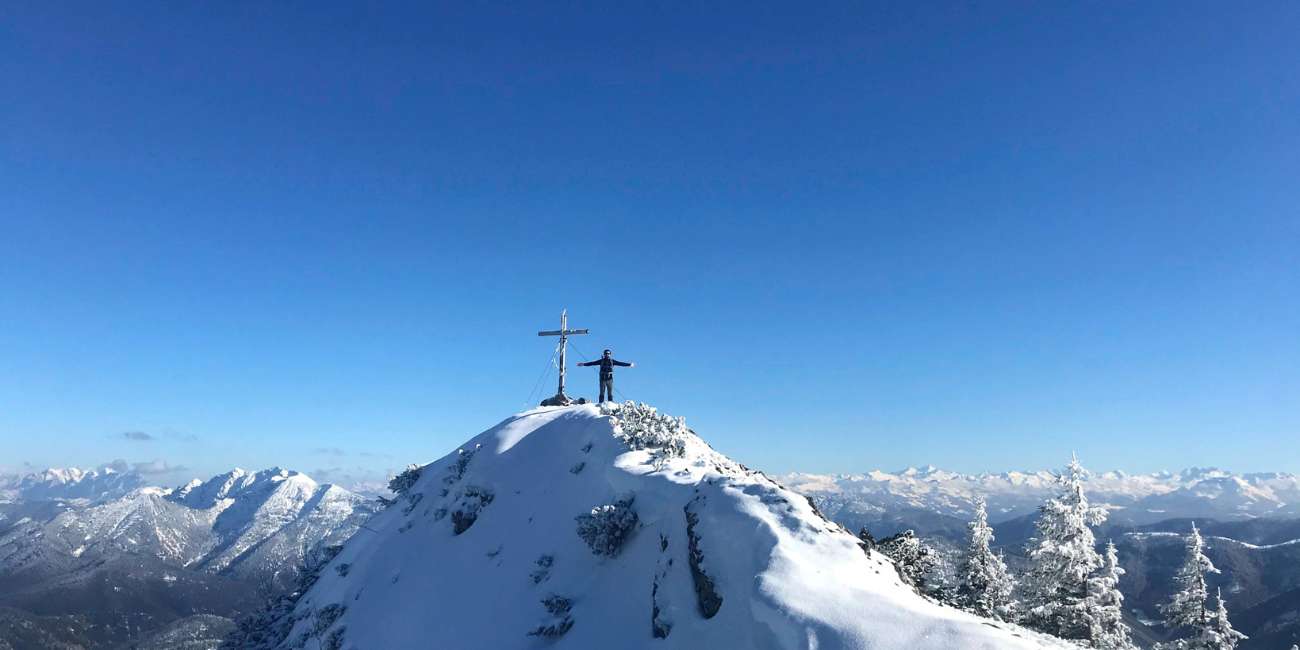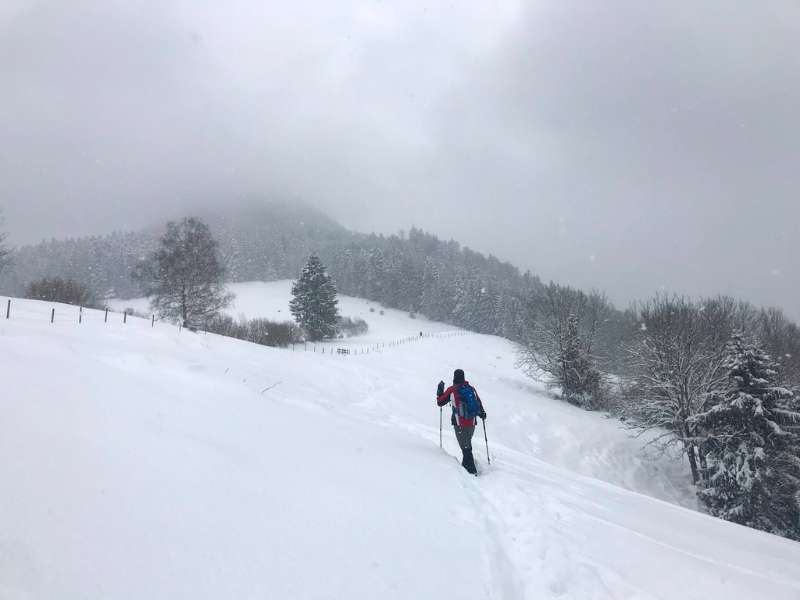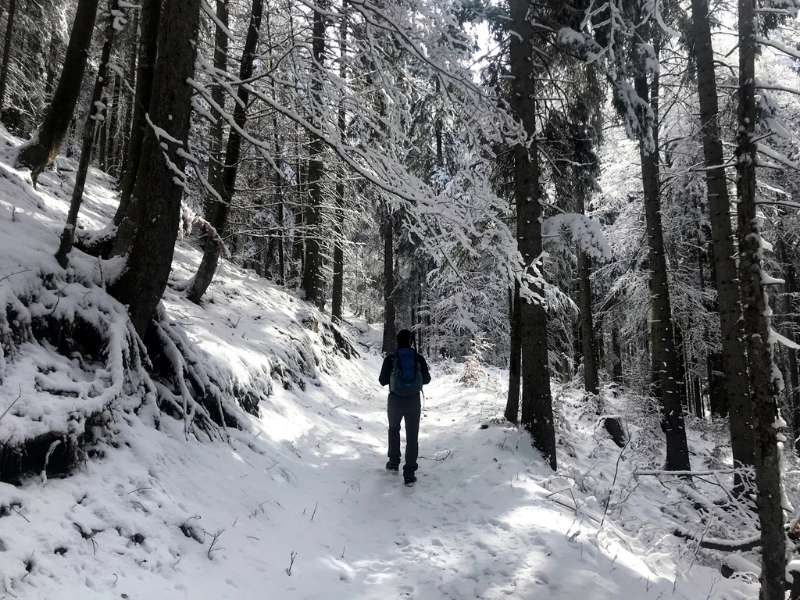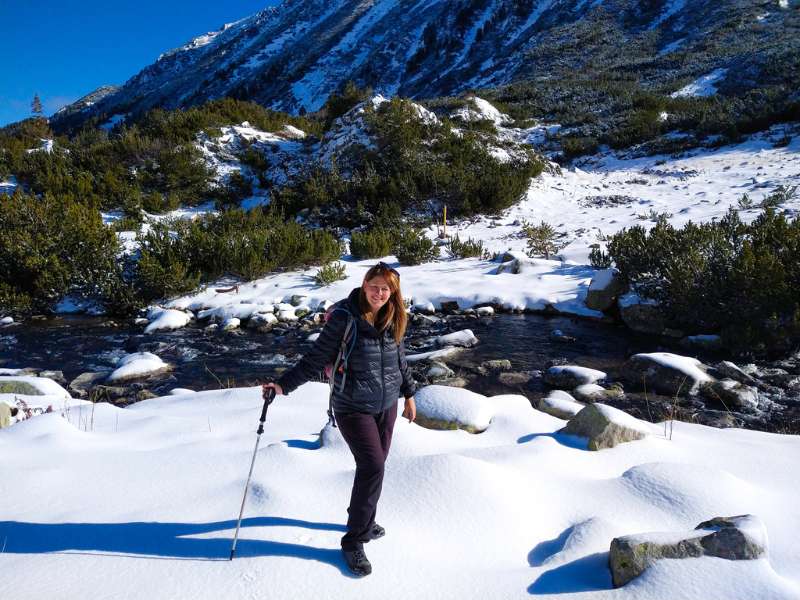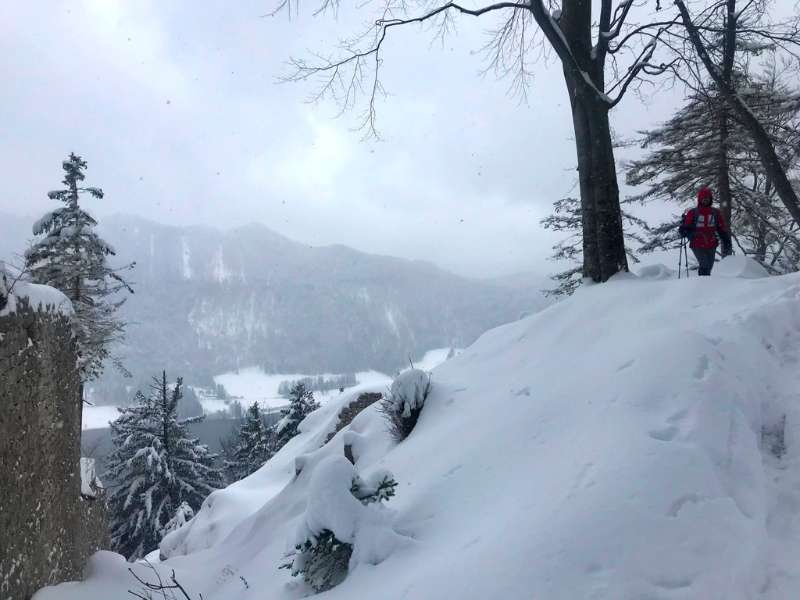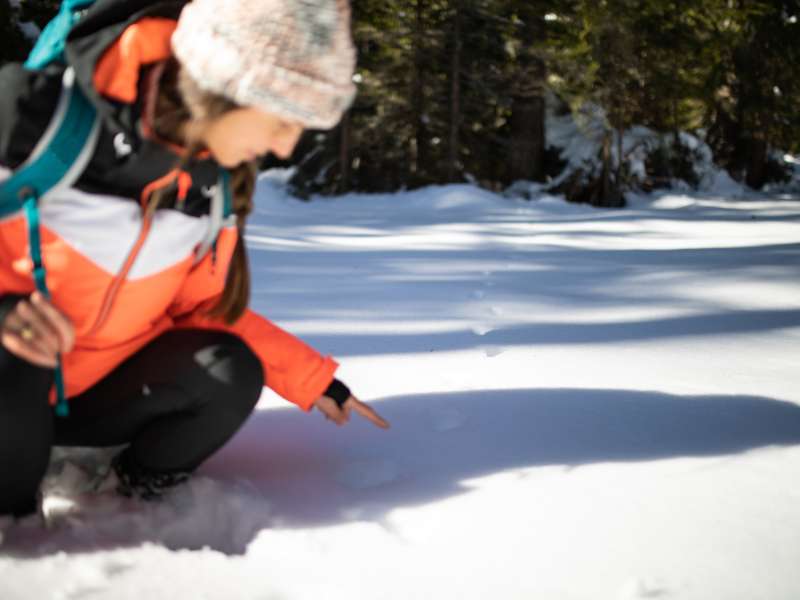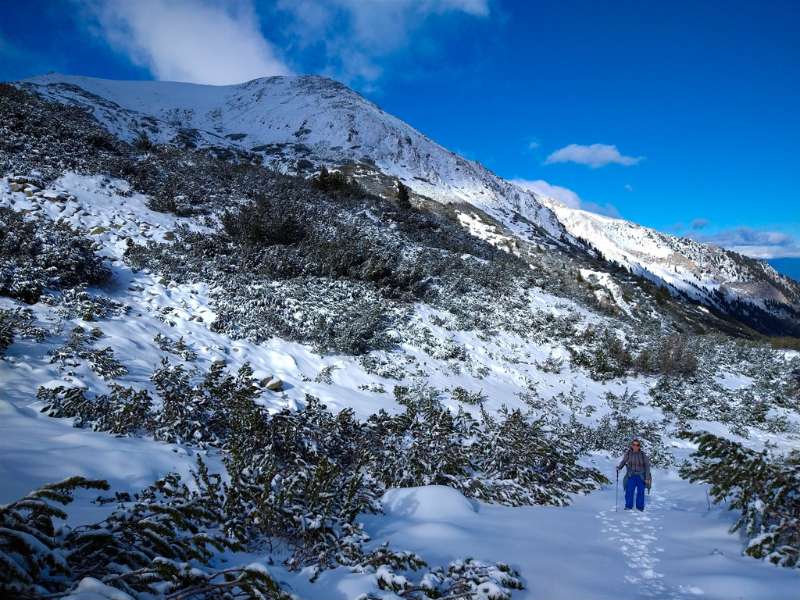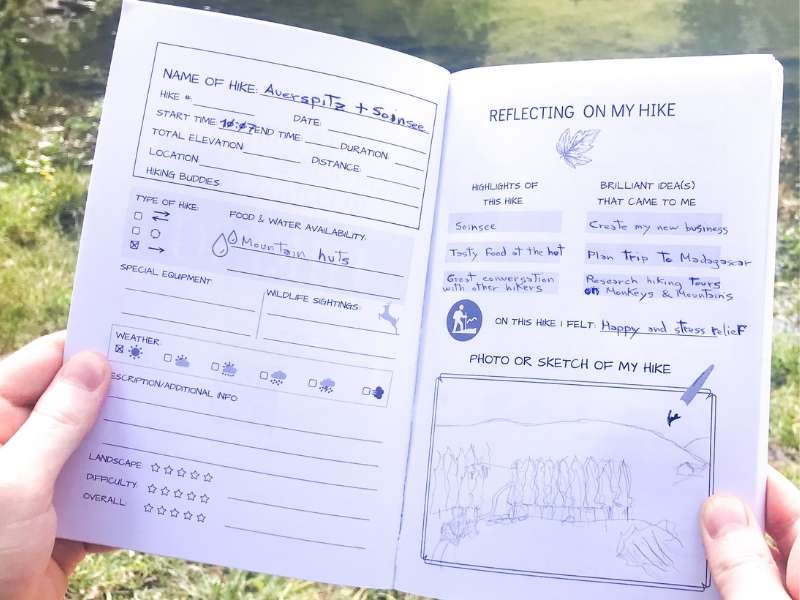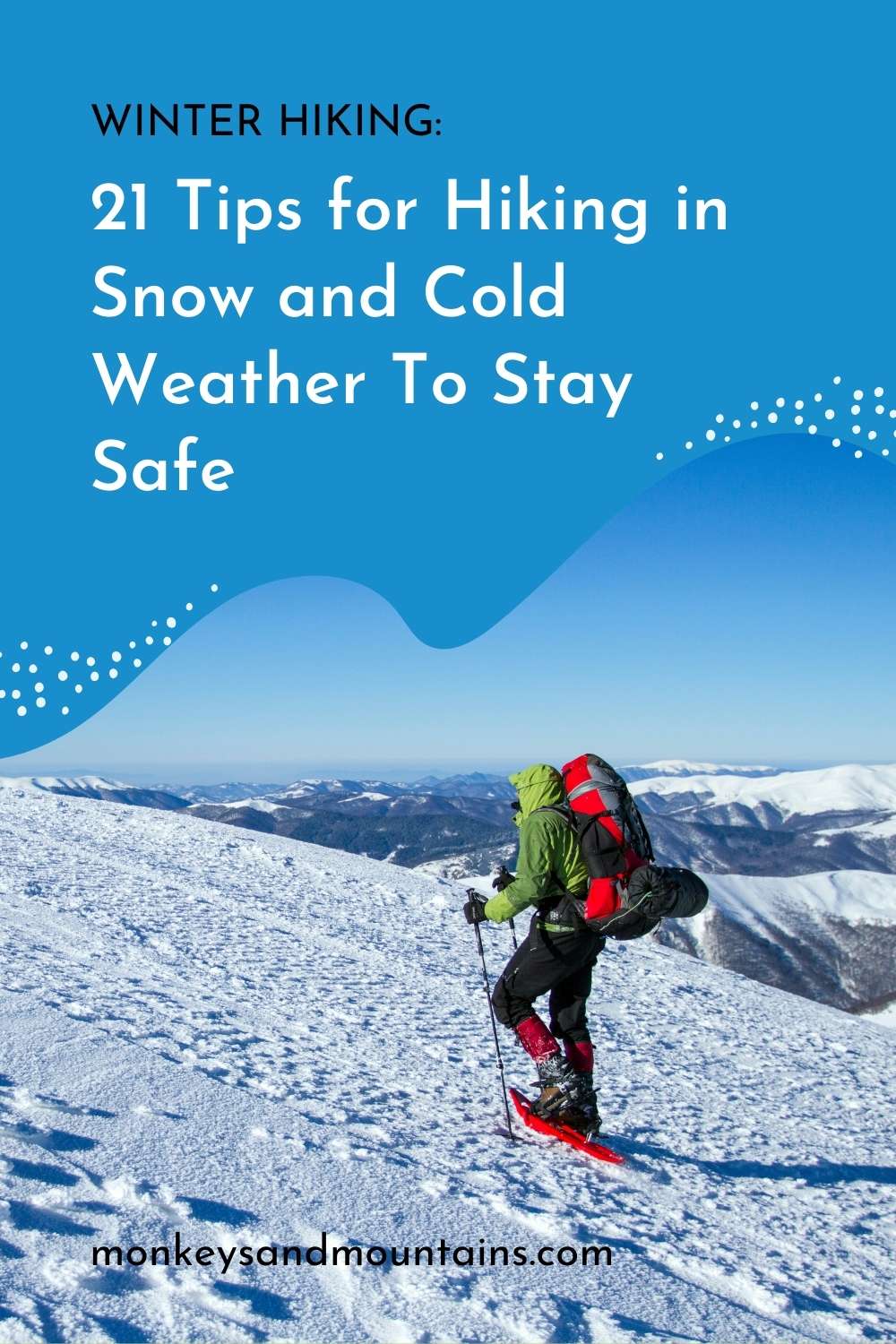Here are my top 22 tips for hiking in snow and cold weather, from dressing properly to choosing the right hiking gear to staying warm and safe.
Table of Contents
With winter weather comes the opportunity to hike in beautiful, snow-covered scenery. But before you hit the trails, there are a few things you should know to stay safe. grab your coat and boots, and let’s get started!
I’ve been hiking for over 20 years. However, it took me a few seasons of summer hiking before I started hiking in winter. Initially, I thought I’d be too cold to enjoy it or that it wasn’t really worth it since you could only do easy hikes.
I couldn’t have been more wrong! I now love winter hiking and do it regularly.
Check out my top winter hiking tips before you head out to ensure that you’ll end up loving it as much as I do!
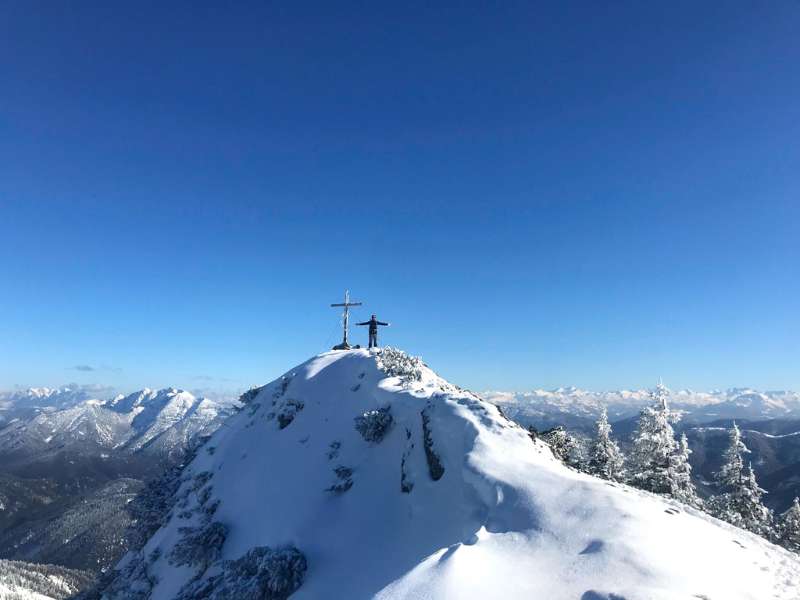
Staying Warm While Hiking in Winter
1) Dress in Layers to Stay Warm and Adjust to Changing Temperatures.
Protecting your extremities from the cold should be a priority. By wearing wool socks, you can ensure that your feet will be dry and healthy due to wool’s superior ability to wick away moisture. Cotton socks do not provide the same level of protection, so wool is always recommended.
For the same reason, avoid a cotton pair of gloves as well and ensure that your gloves are insulated.
You should also bring extra gloves and an extra pair of socks in case yours get wet.
I recommend a fleece-lined hat that you can wear under your coat’s hood. That way, your head will stay warm and dry.
Waterproof boots are a must too! I often wear my regular water-resistant hiking boots in winter but spray them with a waterproof spray first. If you’re hiking in really cold temperatures, then consider insulated winter hiking boots.
With the right combination of layered clothing, staying warm while hiking in cooler temperatures won’t be an issue. Investing in quality winter hiking gear like wool socks, a fleece-lined hat, wool layers and insulated gloves will allow you to enjoy hiking in winter.
Check out our winter hiking gear post for more information.
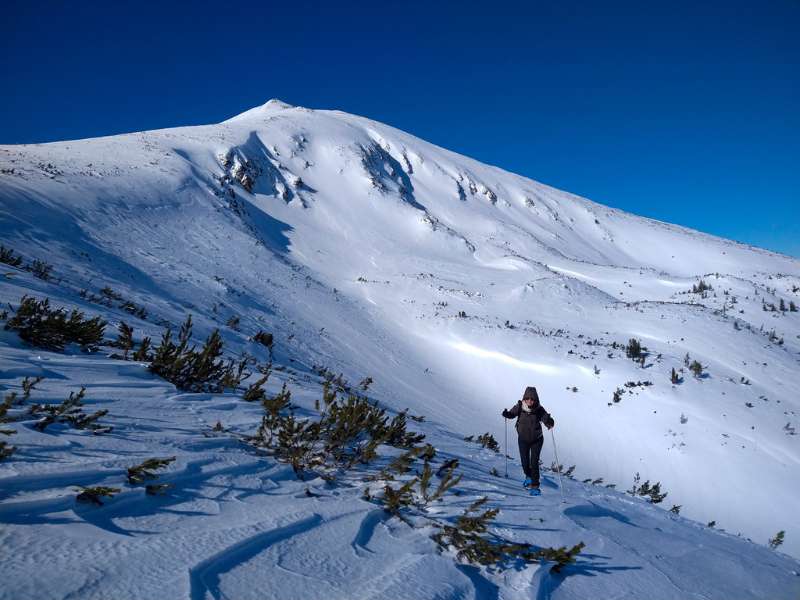
2) Bring Extra Dry Clothing With You In Case Yours Get Wet
When I lived in Calgary and hiked in Banff, it was often a 2-hour car ride home. It’s much more comfortable if you have dry clothes you can change into.
You only have to sit in wet clothing for a long car ride to learn this uncomfortable lesson, which I don’t recommend.
3) Drink a Warm Beverage
Bring an insulated thermos with some coffee, tea, hot cocoa or another warm beverage that can warm you up when you stop for a break.
I often find that my body temperature is OK while I’m hiking in winter conditions but quickly cools off. It’s a treat to drink something warm.
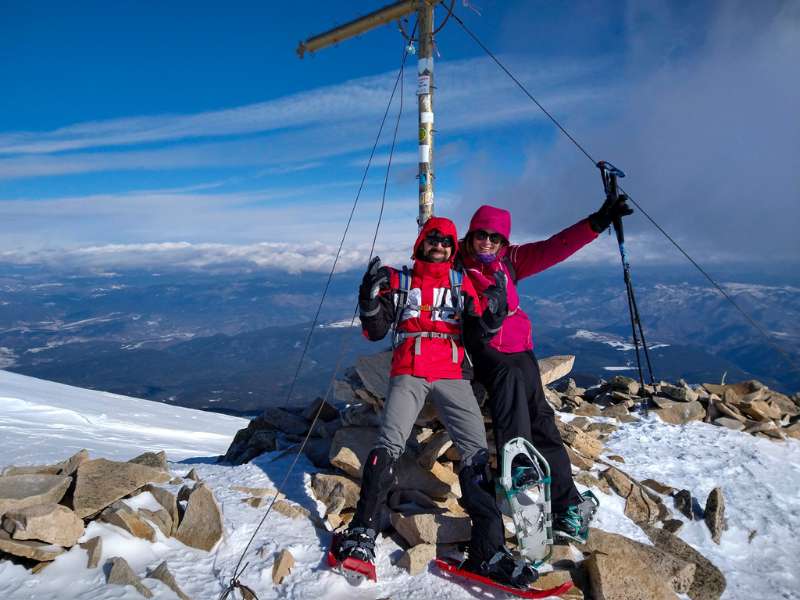
4) Put Your Waterbottle Somewhere Protected So It Won’t Freeze
While it might be convenient to carry your water bottle on the outside of your backpack, in the winter months, it can freeze and leave you with nothing to drink. That’s especially true of water bladders in which the tube freezes.
To avoid this, use other gear to insulate your water bottle. If you’re using a water bladder, then buy an insulating tube to prevent it from freezing.
5) Take Shorter Breaks When Hiking During the Winter Months
As I mentioned above, you’ll cool off very quickly when you stop hiking, so plan for more frequent but shorter breaks. While I might stop for an hour’s lunch when hiking in warmer months, in winter, it’s rarely longer than 10 -15 minutes unless it’s a warm day.
And remember, you still need to hydrate, even if you don’t feel thirsty. So drink something every time you stop for a break.
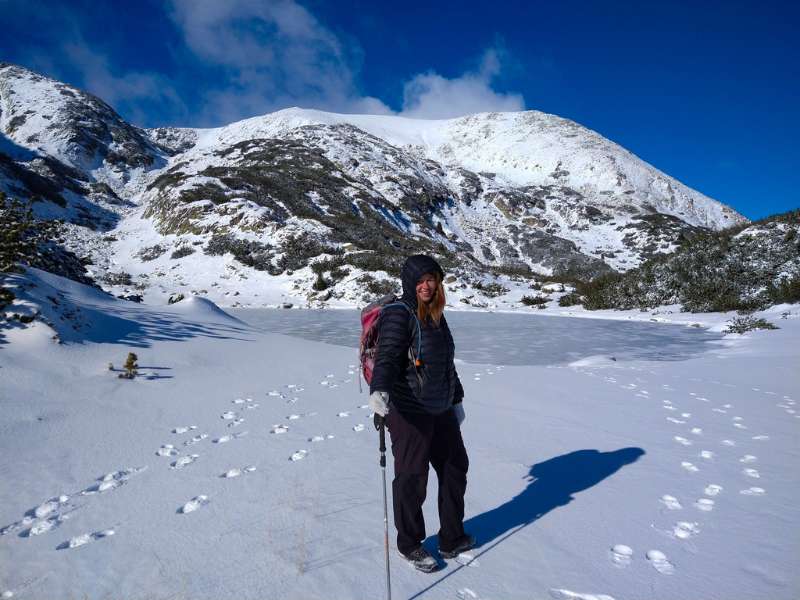
Additional Winter Hiking Gear
In addition to your basic hiking gear, you’ll also want to bring:
6) Choose the Right Footwear – Boots with Good Traction + Microspikes and Snowshoes for Snow and Ice
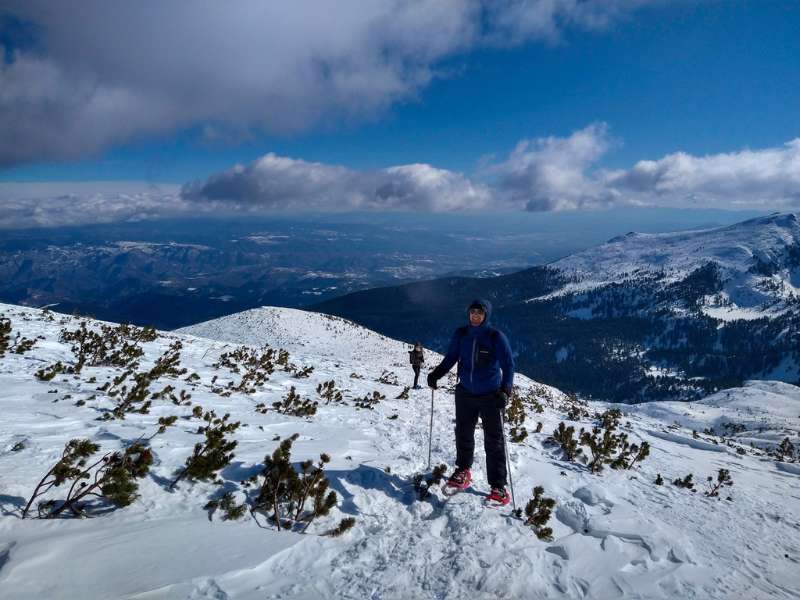
As mentioned above, you’ll want to ensure that your boots are waterproof. Also, ensure that they have a good tread that will provide stable footing when traversing snow drifts or walking on icy trails.
The other essential item you should always carry when hiking in winter are microspikes. These fit over your boot and provide extra traction on icy surfaces and when going up steep slopes.
Depending on the type of winter hike you’re doing, you may also want to bring snowshoes. It really depends on whether you’re hiking on a groomed trail or hiking on a trail that could have deep snow.
I bring my snowshoes on almost every winter hike and often wear them for just part of the hike when the snow starts to get deep. One of the things I love about hiking in winter is that you often don’t know whether you’ll be hiking or snowshoeing, which keeps it interesting.
7) Use Trekking Poles on Winter Hikes
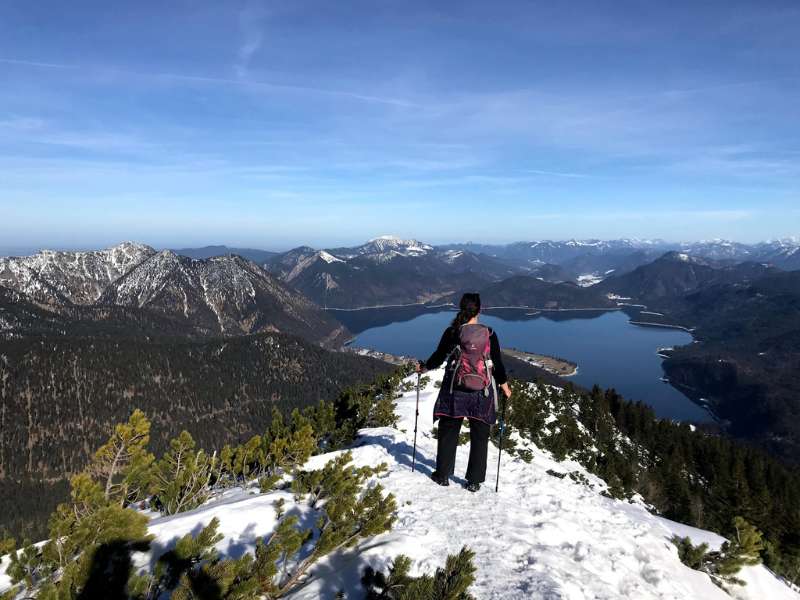
You can use regular hiking poles, as long as they have snow baskets, which keep them from sinking into the snow.
I love using trekking poles at any time of the year, but especially on winter hikes since they provide extra stability and traction on icy terrain.
8) Bring a Pair of Gaiters
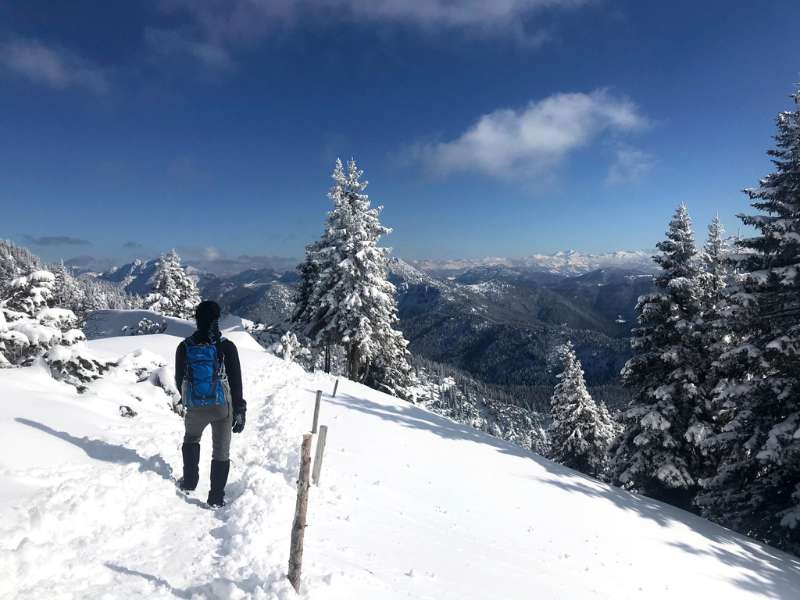
Gaiters fit over your boots and come up to just below your knee. They’re water-resistant and help keep snow out, which is especially useful when you’re hiking in deep snow. Plus, they provide an extra layer of warmth.
Staying Safe While Hiking in Winter
9) Don’t Hike Alone – go with a HIking Buddy or with a Group
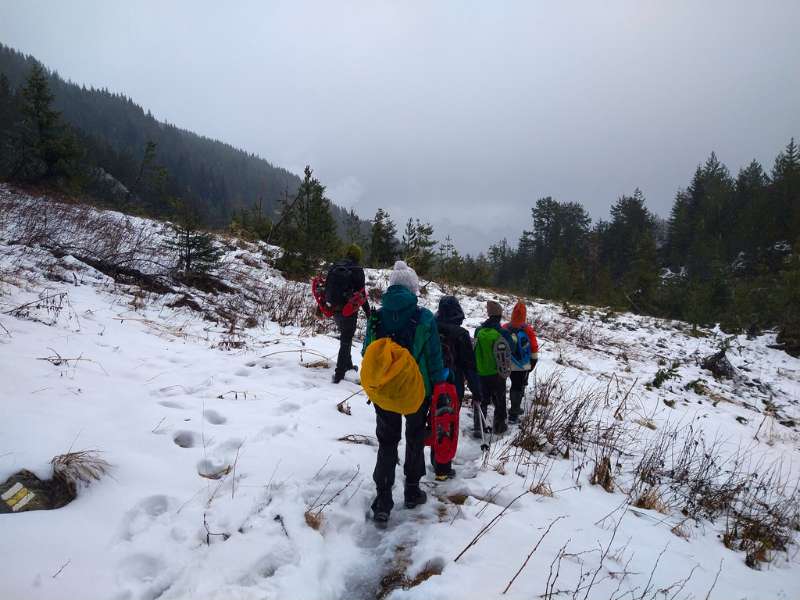
While I love hiking alone, I don’t do it in winter unless I’m not going very far and am going in a popular area.
The extra risks of slipping on ice, cold exposure, and getting caught in changing weather conditions like a blizzard mean it’s much safer to go in a group.
Also, watch out for signs of hypothermia in your hiking buddies. These include shivering, slurred speech, and confusion.
If you or someone in your group starts to exhibit these symptoms, seek shelter and warm up immediately. If that’s not possible, then turn around.
Forget about reaching your destination. Winter hiking requires more flexibility than hiking at other times of the year. You and your hiking buddy‘s safety is far more important than reaching your destination.
10) Be Prepared for Emergencies and Carry a First Aid Kit, Headlamp, Whistle, Fire Starter and a Thermal Blanket
That might seem like a lot, but I carry that in my backpack at all times,e even in summer, with the exception of the fire starter. The most considerable risk of winter hiking is hypothermia.
What if you slipped, twisted your knee and couldn’t walk? While a knee injury is annoying, it’s now become life-threatening if you get hypothermia.
Having the above items will help keep you safe. You can find more info about each of these in our winter hiking gear post.
Related Reading: The 7 Best Microspikes for Hiking in Winter: And Why You Need Them
11) Avoid Hiking in Severe Weather Conditions
Check the weather forecast in the area you’re going to, not in the city you’re coming from. You’ll find the mountain forecast is often much different and more extreme than in the city.
You also need to be prepared for sudden changes in weather conditions, which can happen very quickly in winter, especially in the mountains.
Watch the sky and if you notice a drop in temperature or an increase in wind speed or heavy snow, stop your hike and turn around immediately.
12) Start Your Hike Early in the Day So You’ll Have More Daylight Hours
When hiking in winter, you have less daylight to hike in, so take advantage of the daylight by starting early. You should also know when the sun goes down.
Plan to finish your winter hike one hour before then to avoid getting caught on the trail after dark and to give yourself extra time. In addition to much less visibility, cold temperatures really set in when the sun goes down.
13) Stay on the Marked Hiking Trail to Avoid Getting Lost
While I love exploring and going off the trail when hiking in summer, winter is not the time to do it because of the increased risks. You’ll want to stick to a well-marked trail. Look for one that’s popular in winter as well.
Check out our Banff Winter Hikes so that you’ll see other hikers in case you run into issues and need someone to help.
14) Know If the Trail is Maintained in Winter Before You Start Your Hike
It’s important to know the current trail conditions. Some winter trails are maintained, especially those in national or provincial parks. That means they’ll have packed snow which is much easier to navigate and easier to hike on than an ungroomed hiking trail
Other trails aren’t, so you may be making fresh tracks. Also, without a visible trail, it’s much easier to get lost.
If you’re not yet an experienced winter hiker, then only choose hiking trails that are maintained in winter. Once you have more experience, you can venture off onto less explored trails.
And remember, mountain conditions change quickly, so just because there wasn’t a lot of snow last weekend doesn’t mean that there won’t be this weekend.
15) Always Have a Physical Trail Map of Your Winter Hike
While I love using GPS to map out my hike, phones can freeze quickly in cold conditions and stop working or make your battery run out quickly. Download whatever routes you need beforehand so that you have them offline and put your phone in airplane mode.
Always have a paper trail map with your route clearly marked as a backup. I recommend this at any time of the year, but especially when hiking
16) Choose an Easier Hike in the Colder Months Than You Would in Summer
Hiking in winter is much more difficult than in summer, especially if there’s a lot of snow, which makes each step harder, or if there’s ice, which makes each step slower, so choose an easier hike to start with.
Even if you’re in great shape and regularly do 6-hour hikes, you may find that it’s too long in the cold.
17) Plan For the Unexpected On Your Winter Hike
There have been many more times that I’ve had to turn around in winter and not reach my destination than there have been when I was hiking in summer.
Don’t be afraid to do so. While it’s normal to be cold when you first start hiking, if you’re still cold after 10 minutes, turn around. Don’t continue.
You may also find there’s more snow than expected, or a bigger risk of an avalanche than anticipated, or that a trail you thought was maintained isn’t.
When hiking in winter, you’ll often have to adapt your plan. Remember, it’s more important to be safe than to reach a lake or a peak.
18) Be aware of Avalanche Danger When Hiking in Mountainous Areas
You should avoid hiking in avalanche-prone areas unless you are trained and equipped to handle them. If you’re unsure, then hike at a provincial, state or national park when you can check in and ask which areas are safe before you start hiking.
It’s also a good idea to take an avalanche awareness course so that you familiarize yourself with what to look for and what to do if you do get caught in one while winter hiking.
19) Look for Signs of Wildlife
One of the great things about hiking in winter is that wildlife tracks are much easier to see. If you see there are fresh deer tracks; you can keep going. However, if you notice fresh cougar tracks, you should turn around.
It’s unlikely; however, it has happened to me on two hikes in the Canadian Rockies. Fortunately, I turned around and avoided running into the cougar on the trail.
20) Tell Someone the Name of Your Hiking Trail
Before I head out on a winter hike, even if I’m going with a hiking buddy, I always tell someone where I’m going and when I’m expecting to return. I tell them the name of the hike I’m doing and send them the GPS tracks of the hike to make it easier to find me.
With a solid safety plan in place, it will give both myself and those at home peace of mind as I explore the outdoors.
21) Document Your Hikes in a Hiking Journal
Keeping a log book of your hikes in a hiking journal is a great way to see your progress. It’s also a good place to note the temperature and weather conditions and the gear you brought to help you plan for future hikes. I.e. if you were cold and it was -10C (14F) by writing it down, you can review it before your next hike and prepare better.
Plus, the hiking journal I created also has a section to write down any ideas or reflections that came to you while hiking. I often get great ideas hiking that I don’t get in my daily life.
22) Leave No Trace
This applies when you’re hiking at any time of the year, but bears repeating. Pack out what you pack in. That includes whatever trash or food waste you generate while hiking, even organic food waste, like an apple core.
Not only is it considerate of other hikers who may follow behind you, but it also helps keep our trails clean. You can see the seven principles here.
Related Reading: 11 Arctic Explorers To Inspire Your Own Polar Travels
